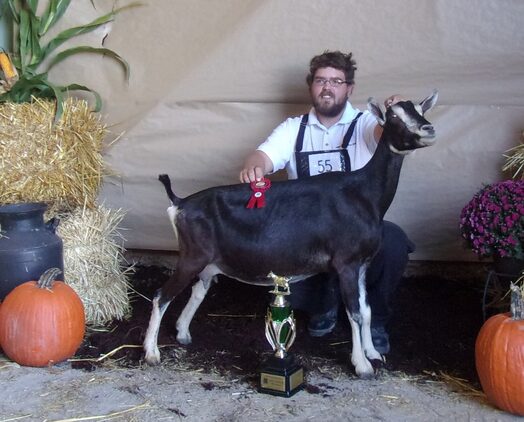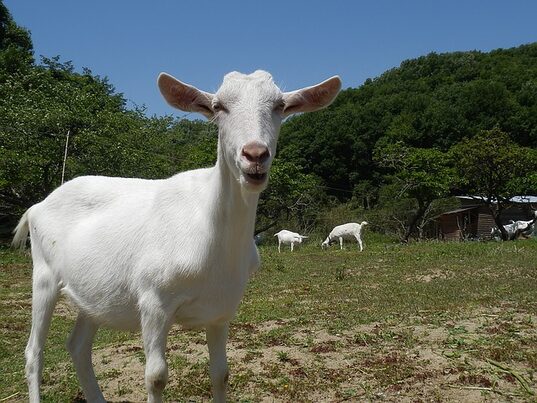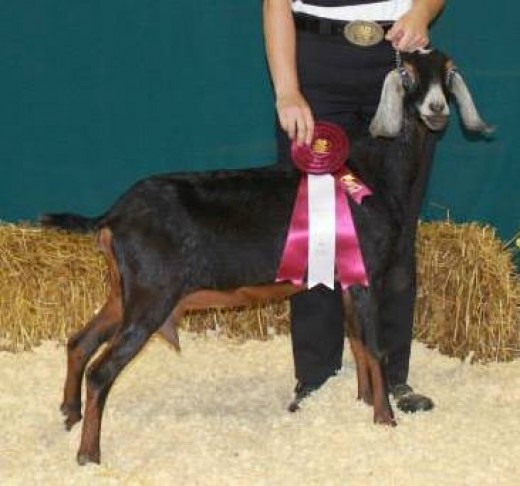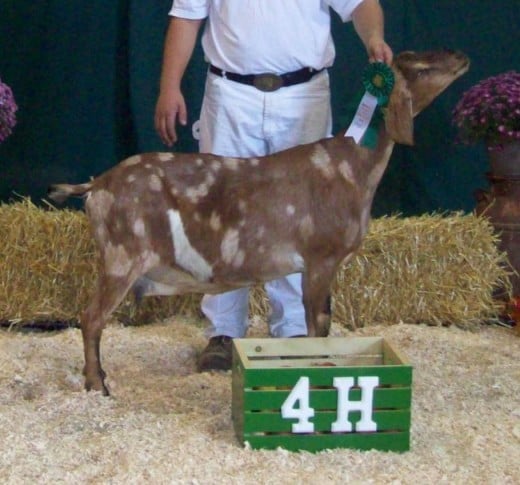We've been working with our 4H Goat Club all summer, teaching them how to train and show their goat, and also helping them learn the facts they need to know for the show ring. Unlike most other types of animals, where only the handling of the animal is judged, goat judges ask the showpeople a variety of questions to see if they have enough goat knowledge to deserve to win the class. They will ask them about breeds, parts of the goat, the judging scorecard, and could also ask them to define what traits they like and don't like about their goat. Often they are asked to switch goats and show another member's goat. They are expected to be able to answer questions about that goat too.
There are several dairy goat breeds recognized in Canada. The following are the most common in dairy herds.
The Alpine

Matthew Welch with his mature Alpine doe Grace after they won top honors at the Leeds County Showcase this fall.
Also known as the French Alpine, this medium to large sized goat is known as the Holstein of the goat world. Their milk is the lowest fat of all milk. Does can be any colour or combination of colours, but bucks cannot be all white.
Alpines are names as such because they originated from the French Alps.
Does stand about 30” tall and weigh an average of 125lbs. Alpines are popular on hobby farms, and commercial dairies. Under optimal conditions, an Alpine goat will produce about 2,100lbs of milk in a lactation.
Alpines are very adaptable and can thrive in many environments. Early voyages would take goats along for milk and meat. Sometimes they would leave a few goats on islands they passed, then stop to catch some of them on return trips.
Goats were listed as valuable assets in a 1630 census of Jamestown.
Alpines have erect ears and a slightly dished face with a fine muzzle.
Nubians
Cambraelyn Melissa - A mature Nubian Doe showing unique coloring and exceptional body capacity.
Nubians are known for their long, floppy ears, and Roman noses. To meet breed character, the ears must reach past the end of the nose and flare out at the bottom, sort of forming a bell shape.
Nubians come in a lot of colours, and are especially stunning when they are spotted.
The does stand about 30” tall and weigh an average of 135lbs. They are usually solidly built, with wide chests and solid bone. When bred to Boer bucks, Nubian does produce exceptional meat kids. When milked, Nubians have the highest butterfat of the goat breeds.
This breed originated in England when the Old English Milch Goat was crossed with bucks imported from India, Russia and Egypt. Due to their size and strength, they were used for milk, meat and sometimes as pack animals.
Saanen

Stock Photo from www.pixabay.com
A Saanen is an excellent dairy goat that is almost always pure white. There is a recessive variety called Sable that can be colors other than white, but these are not recognized in all breed clubs.
Saanens are the largest of the dairy goats, weighing up to 160lbs. Their face is similar to that of the Alpine, erect ears, and a small, fine muzzle. They tend to be very good tempered and get along in large herds. They are the most common breed found on large commercial dairies.
Because they are white, they are more sensitive to sunlight than other breeds.
Toggenburg
Toggenburgs are from the Toggenburg Valley in Switzerland. They are a medium sized breed that is usually gray in color, with specific white markings in the ears, on the face, and on the legs. Most Toggenburgs have ‘toggles’ or wattles under their jaws.
Does average 120lbs. They will be disqualified from registration if they display more than one color with their white markings. Black does are accepted, but black bucks are not.
Toggs, as they are sometimes called are one of the oldest breeds ever recorded. There are registrations dating back as far as the 1600s.
LaMancha
LaMancha goats are probably originally from La Mancha, Spain; though the breed was officially developed in the United States. They are distinctive from other breeds because of their unique ears. They appear to have no ears, though most do have small ‘gopher’ ears held close to the head. The ears must be shorter than 1”.
LaManchas have been around for many years, but were only officially recognized in the 1950s. Any color of goat can be registered. Does average 130lbs full grown.

